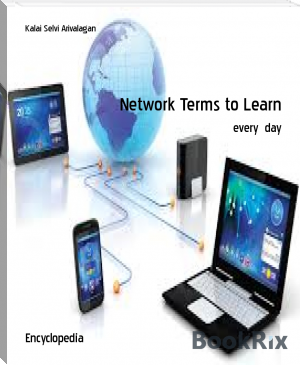Network Terms to Learn by Kalai Selvi Arivalagan (short books to read txt) 📖

- Author: Kalai Selvi Arivalagan
Book online «Network Terms to Learn by Kalai Selvi Arivalagan (short books to read txt) 📖». Author Kalai Selvi Arivalagan
Self-Supervised Learning (SSL)
Self-supervised learning (SSL) is an approach to machine learning allows machine learning algorithms to use observed inputs to predict unknown inputs. An important goal for self-supervised learning is to programmatically change unsupervised learning models into supervised learning models by developing pre-training deep learning systems that can learn to fill in missing information.
BERT (Bidirectional Encoder Representations from Transformers) and Q Learning are perhaps two of the most well-known applications of self-supervised learning in AI. During the pre-training phase, each system is shown a short example of text in which some of the words are missing. The systems are then trained how to extract supervisory signals from the input data in order to predict the missing words accurately. SSL and has played an important role in the development of natural language processing (NLP). It is one of several approaches being studied to reduce the need for massive amounts of data to train AI learning algorithms.
Term of the day - 17 Liquid State Machine
A liquid state machine (LSM) is a machine learning model or system that is part of a series of particular neural network models. These models build on traditional designs to introduce new and innovative ways of processing information. Like other kinds of neural networks, liquid state machines and similar builds are based around the neurobiology of the human brain.
Output Layer
The output layer in an artificial neural network is the last layer of neurons that produces given outputs for the program. Though they are made much like other artificial neurons in the neural network, output layer neurons may be built or observed in a different way, given that they are the last “actor” nodes on the network.
Derivative Work Right
A derivative work right is the legal permission to develop a new work derived from an original work protected under copyright law. Derivative work rights are only granted for derivative works with original content, versus duplicated copyrighted material. The original author's permission to transform or adapt an original work by the original owner is the essence of a derivative work right.
Hot Add
Hot add refers to the ability to dynamically add hardware, virtual or physical, to a running system without downtime.
Merkle Tree
A Merkle tree is a specific type of data construct in which each non-leaf node of the tree contains hash values of its own child nodes. Because a Merkle tree demonstrates effective hashing techniques, it is popular in many industries and is being used to help innovate in finance.
Deep Belief Network
A deep belief network (DBN) is a sophisticated type of generative neural network that uses an unsupervised machine learning model to produce results. This type of network illustrates some of the work that has been done recently in using relatively unlabeled data to build unsupervised models.
Activation Function
An activation function is the function in an artificial neuron that delivers an output based on inputs. Activation functions in artificial neurons are an important part of the role that the artificial neurons play in modern artificial neural networks.
Do It With Others
Do It With Others (DIWO) is a joint project development model that enables like-minded people to collaboratively work on a task, project or any other service. Do It With Others aims to provide a collaboration platform for individuals and businesses seeking help or participation from a generic audience and specialists to achieve a specific goal or objective. Do It With Others may also be known as Do It Together (DIT).
Restricted Boltzmann Machine
A restricted Boltzmann machine (RBM) is a type of artificial neural network invented by Geoff Hinton, a pioneer in machine learning and neural network design. This type of generative network is useful for filtering, feature learning and classification, and it employs some types of dimensionality reduction to help tackle complicated inputs.
Black Box Testing
Black box testing is a software testing technique that focuses on the analysis of software functionality, versus internal system mechanisms. Black box testing was developed as a method of analyzing client requirements, specifications and high-level design strategies. A black box software tester selects a set of valid and invalid input and code execution conditions and checks for valid output responses. Black box testing is also known as functional testing.
Modular Neural Network
A modular neural network is one that is composed of more than one neural network model connected by some intermediary. Modular neural networks can allow for sophisticated use of more basic neural network systems managed and handled in conjunction.
CPU Ready Queue
A CPU ready queue is a queue that handles jobs or tasks for eventual scheduling with a processor. The term is often used in virtualization setups, where IT professionals try to determine whether resources have been allocated well and whether different components of the system can work efficiently.
Offline
"Offline" refers to a device not connected to a network. It may also be used for a device that is not working properly, such as an "offline printer." Offline can additionally refer to the "real world" outside of the internet. This is normally used to distinguish between online and offline communications, such as email vs. "snail mail.
Overfitting
In statistics and machine learning, overfitting occurs when a model tries to predict a trend in data that is too noisy. Overfitting is the result of an overly complex model with too many parameters. A model that is overfitted is inaccurate because the trend does not reflect the reality of the data.
Data Center Container
A data center container is a self-contained module produced inside a custom-built shipping container that includes a series of rack-mounted servers, along with its own lighting, air conditioning, dehumidification and uninterruptible power supply (UPS). Designed to save deployment resources, data center containers can be easily relocated and installed in parallel with others to build large modular data centers. Another advantage is that they can be up and running, replaced or upgraded in equally short order. A data center container is also known as a data center-in-a-box or modular data center.
Peterson's Algorithm
Peterson's algorithm is a concurrent programming algorithm developed by Gary L. Peterson in a 1981 paper. It is known as a simple algorithm when compared to others. Peterson proved the algorithm using both the 2-process case and the N-process case. Peterson's algorithm is used for mutual exclusion and allows two processes to share a single-use resource without conflict. It uses only shared memory for communication. Peterson's formula originally worked only with two processes, but has since been generalized for more than two.
Secure Hash Algorithm
A secure hash algorithm is actually a set of algorithms developed by the National Institutes of Standards and Technology (NIST) and other government and private parties. These secure encryption or "file check" functions have arisen to meet some of the top cybersecurity challenges of the 21st century, as a number of public service groups work with federal government agencies to provide better online security standards for organizations and the public.
Password Protection
Password protection is a security process that protects information accessible via computers that needs to be protected from certain users. Password protection allows only those with an authorized password to gain access to certain information.
Form Factor
A form factor is the overall design and functionality of a computer or piece of electronic hardware. It is usually highlighted by a prominent feature, such as a QWERTY keyboard, a touch screen or the way the device opens and closes. In essence, it is the schematic template that defines the specifications about the layout of a certain device, such as its size, number of ports, power supply type and position of components. A form factor can also serve as a standard or category that can be used to ensure that there is a level of hardware compatibility between devices of similar types, even though they may come from different manufacturers. In this regard, form factor is important, as it affects both the aesthetics and recognizability of a given device as well as its performance and usability. The term sometimes refers to programming or software as well. In this case, it describes the size of the program, such as the amount of memory needed to run it.
Batting
Batting is an Internet meme in which participants hang upside down to resemble a bat with a photographer nearby to capture the unusual pose. The photograph is then downloaded to a favorite website or social networking site.
This is one of several popular Internet gags, which include coning, planking and owling.
Finger
Finger is a networking tool and one of the earliest computer networking programs that enabled a user to view another user’s basic information when using the same computer system or logged on in the same network. The program can determine user identity though an email address and determine whether that user is currently logged in, as well as the status of their log sessions. It was originally created by Les Earnest in 1971 and later became a standard part of BSD UNIX, and was commonly used by Windows users. This was later interfaced by David Zimmerman with the Name program to become the Name/Finger Protocol in 1977.
Nanobot
Nanobots are robots that are microscopic in nature, measured largely on the scale of nanometers. They are currently in the research and development phase, but on realization they are expected to do specific tasks at the atomic, molecular and cellular level and help in bringing about many breakthroughs, especially in medical science. Nanobots are also known as nanomachines, nanorobots, nanomites, nanites or nanoids.
Finger
Finger is a networking tool and one of the earliest computer networking programs that enabled a user to view another user's basic information when that user used that same computer system or was logged on in the same network. The program can determine user identity though an email address and determine whether that user is currently logged in, as well as the status of their log sessions. It was originally created by Les Earnest in 1971 and later became a standard part of BSD UNIX, and was commonly used by Windows users. This was later interfaced by David Zimmerman with the Name program to become the Name/Finger Protocol in 1977.
Alureon
Alureon is a Trojan, rootkit and botnet that is designed specifically to intercept network traffic and extract sensitive and confidential information from it, enabling the attacker to steal information transmitted over a network connection. Alureon is also known as TDSS and TDL-4.
Kyoto Cooling
Kyoto cooling is a cooling alternative for data centers and other infrastructure. Kyoto cooling can





Comments (0)